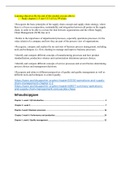Samenvatting
Summary Introduction to Operations and Supplychain management II y1q2
- Vak
- Instelling
- Boek
This is an summary for the course operations and supplychain management of avans hogescholen. everything you need to study is in this document.
[Meer zien]




